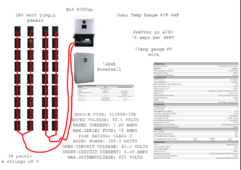NorthShoreOahu
New Member
I have 36 Yingli panels (280 watt)
I have and eg4 6000xp and the eg4 battery on the way to me.
Planning on running 4 strings of 9 panels to stay under the 480v limit of the 6000xp.
Should I add a combiner box or a fuse to each string or will the 16 amps per MPPT be fine.
Also-- I have seen a few videos where people say that I shouldn't ground the panels if they are going into an 6000xp. Should I be running wire in between all the panels and down to the ground or is there grounding built into the 6000xp unit.
I understand that the 6000 xp comes with a PV switch in the box.
More on the panels
MODULE TYPE: YL280P-35b
RATED VOLTAGE: 35.5 VOLTS
RATED CURRENT: 7.89 AMPS
MAX.SERiES FUSE: 15 AMPS
FIRE RATING: CLASS C
RATED POWER: 280.0 WATTS
OPEN-CIRCUIT VOLTAGE: 45.0 VOLTS
SHORT-CIRCUIT CURRENT: 8.35 AMPS
MAX.SYSTEMVOLTAGE: 600 VOLTS

I have and eg4 6000xp and the eg4 battery on the way to me.
Planning on running 4 strings of 9 panels to stay under the 480v limit of the 6000xp.
Should I add a combiner box or a fuse to each string or will the 16 amps per MPPT be fine.
Also-- I have seen a few videos where people say that I shouldn't ground the panels if they are going into an 6000xp. Should I be running wire in between all the panels and down to the ground or is there grounding built into the 6000xp unit.
I understand that the 6000 xp comes with a PV switch in the box.
More on the panels
MODULE TYPE: YL280P-35b
RATED VOLTAGE: 35.5 VOLTS
RATED CURRENT: 7.89 AMPS
MAX.SERiES FUSE: 15 AMPS
FIRE RATING: CLASS C
RATED POWER: 280.0 WATTS
OPEN-CIRCUIT VOLTAGE: 45.0 VOLTS
SHORT-CIRCUIT CURRENT: 8.35 AMPS
MAX.SYSTEMVOLTAGE: 600 VOLTS



